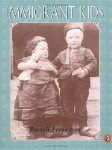Through the Looking Glass Children's Book Reviews
Immigrant Kids
Nonfiction
For ages 8 to 11
Penguin, 1995 ISBN: 978-0140375947
Between 1880 and 1920 twenty-three million immigrants came to the United States looking for a better life. Many of these people were poor, many were fleeing from persecution of one kind or another, and many of them were children. Because they had so little these immigrants often traveled across the Atlantic as steerage passengers and the journey was usually a miserable ordeal. Arriving in America was therefore all the sweeter for not only did it mean that they were in their new homeland, but it also meant that they were getting of the ship.
On arriving in the United States the steerage passengers were taken to Ellis Island were they were given a health examination and then questioned at length by immigration officers. This was often a very frightening experience for the new arrivals for there was always that chance that they might not pass these crucial tests and might be sent back home.
Once the immigrants passed their examinations they were then allowed to enter New York City. Some immigrants went on to other cities and towns but a large number stayed in New York swelling the numbers of people who were already living in the tenement districts. Families soon found that finding a place to live that they could afford was not easy and it was normal for a large family to live in a tiny two room apartment. Some of the children would start attending school but it would be hard at first because they would have to learn English and there were no special classes available to help them do this. They just had to muddle along as best they could.
Because money was often so tight in these immigrant families the children frequently had to work. Though they had to be fourteen before they were legally allowed to work, the law was not strictly enforced and children who were much younger than fourteen often had jobs in factories and shops, or they worked at home with their parents making silk flowers or sewing together items of clothing.
Some children tried to keep up their education by going to night school but it was hard to work full time and still have the energy to study at night. All in all it was a very hard life with only a few breaks now and then when these immigrant children could truly forget their responsibilities for a little while and be children again.
Often when we think about the immigrant experience we think about the journey and the difficulties experienced while getting to the final destination. We don’t wonder so much about what happens to the immigrants after they have arrived. In this excellent book, Russell Freedman tells the stories of newly arrived immigrant children who live in big cities and whose families have to struggle very hard to survive. Though the journey was hard, the new life in America was infinitely harder. Using the words of people who really experienced the lives described in the text, Freedman brings the immigrant world to life, helping his readers to see what it would have been like to be such a child at such a time. The numerous period photographs are often very moving and the faces of the children looking out at the reader seem timeless and immediate.
Wonderfully written and carefully presented, this title is sure to give readers plenty to think about.




